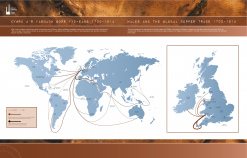A World of Welsh Copper
.jpg&tn=2&prop=1) By 1851 Wales had become the world’s first industrial nation and the copper industry was at its heart. These guides provide insights into the intriguing story of how Welsh businesses led the global copper trade for most of the eighteenth and nineteenth centuries.
By 1851 Wales had become the world’s first industrial nation and the copper industry was at its heart. These guides provide insights into the intriguing story of how Welsh businesses led the global copper trade for most of the eighteenth and nineteenth centuries.
This is not a simple story of industrial ‘boom and bust’ but a complex one of fluctuations in supply and prices, intense competition at home and abroad, and the development of a skilled workforce and new communities.
The Birmingham Tea Vase sums up a world of Welsh copper in a single object and represents some of the complex globalising networks that were growing by the end of the eighteenth century.
Birmingham was at the centre of the mass production boom of the Industrial Revolution. its manufactories were major consumers of Welsh copper and brass and the city's industrialists, especially Matthew Boulton, grew their interests in Welsh copper and brass smelting by opening their own works in Swansea.
The globalisation of commodities such as tea prompted new types of object to be designed. The East India Company held a monopoly on many imported commodities, including tea. In turn, the Company became major purchasers of Welsh copper and brass for export to South Asian markets.
And so the global trade and business networks centred on copper grew, and grew.
Copper tea vase, made by Boulton and Fothergill in Birmingham, about 1770
Boulton and Fothergill made tea urns in silver, Sheffield Plate and bronzed copper. This is one of their earliest examples and is probably made of copper smelted in Wales. Matthew Boulton was heavily involved in the Welsh smelting industry specifically to provide materials for his manufacturing businesses in Birmingham.By 1770 tea from China had become a very desirable drink. The East India Company operated a monopoly and imported over ten million pounds in weight of tea into Britain annually. That’s about one billion cups of tea.
Birmingham Museums and Art Gallery (Object no. 1887M934)Cawg te copr, wedi’i wneud gan Boulton a Fothergill yn Birmingham, tua 1770
Roedd Boulton a Fothergill yn gwneud yrnau te mewn arian, plât Sheffield a chopr pres. Dyma un o’u rhai cynharaf ac mae’n debyg ei fod wedi ei wneud o gopr a fwyndoddwyd yng Nghymru. Roedd Matthew Boulton â rhan fawr yn y diwydiant mwyndoddi yn benodol i ddarparu deunyddiau ar gyfer ei fusnes cynhyrchu yn Birmingham.Erbyn 1770 roedd te o Tseina wedi dod yn ddiod dymunol dros ben. Roedd Cwmni Dwyrain India’n gweithredu monopoli ac yn mewnforio dros ddeg miliwn pwys o de i Brydain bob blwyddyn. Mae hynny’n rhyw biliwn o baneidiau o de.
Oriel ac Amgueddfeydd Birmingham (1887M934)
Wales and the World Copper Trade

Download Wales and the Global Copper Trade 1700-1914 / Dadlwytho Cymru a’r Fasnach Gopr Fyd-eang 1700-1914 and display it in your classroom or office! (PDF, 586KB)
Bilingual Cymraeg-English text is provided as PDF downloads available with each guide. Look for downloads in this section of the page.
Acknowledgements / Diolchiadau
You can visit the Byd Copr Cymru-A World of Welsh Copper exhibition at the National Waterfront Museum, Swansea 2 July to 16 October 2011.
A World of Welsh Copper was created as a museum exhibition by the Global and Local Worlds of Welsh Copper Project, funded by the Economic and Social Research Council and based at Swansea University. All the partners in this project, in addition to many other contributors, have brought together the latest research on copper for this exhibition.
For their help with this exhibition the partners of the Global and Local Worlds of Welsh Copper Project would like to thank:
Mae partneriaid Prosiect Bydoedd Lleol a Byd-eang Copr Cymru am ddiolch i’r canlynol am eu cymorth gyda’r arddangosfa hon:
Catrin Alun
Staff Amgueddfa Cymru-National Museum Wales
Vin Callcut
Copper Development Association UK / Cymdeithas Datblygu Copr y DU
Copper Kingdom Project (Amlwch Industrial Heritage Trust) / Prosiect Teyrnas Copr
(Ymddiriedolaeth Treftadaeth Ddiwydiannol Amlwch)
Dr. Kevin Cordes
Cornish Mining World Heritage Site Office
Mel Davies
Richard Haines
Stephen Hughes
Dr. Manuel Llorca-Jaña
London Metal Exchange / Cyfnewidfa Metel Llundain
Dr. Bode Morin
Swansea Library Service / Gwasanaeth Llyfrgelloedd Abertawe
Swansea Museum / Amgueddfa Abertawe
Waters Creative
Penny Watts-Russell
Download Introduction / Dadlwyth Cyflwyniadau (PDF, 1.1MB)

